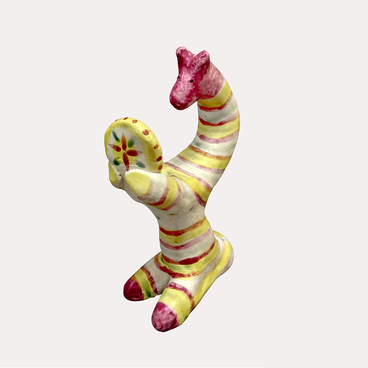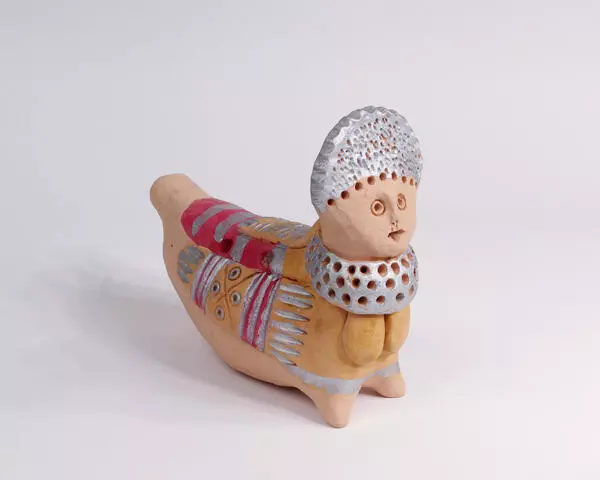The female figure, created in 2011 by Viktor Markin, embodies the traditional image of the Romanovo clay toy. She is called ‘romanushka’ or ‘bereginya’ and is considered the keeper of the hearth, the patron of the family. The bereginya is dressed in a folk Romanovo costume: a red shirt, a bright skirt, colorful satin ribbons, a few rows of beads. There is a kokoshnik on her head. Some details are painted in silver.
The name ‘Romanovo’ comes from the name of the area. There is a picturesque Troitsk village not far from Lipetsk, on the bank of the Voronezh River. It used to be a part of a large village located on three hills and was called Romanovo. There were abundant deposits of black, red, and yellow clay in this area. Local peasants made pottery from it — some items were for their own needs, other products were sold at the fair. They also made toys-whistles.
The earliest toys of this kind date back to the 17th century. Clay whistles of that time were made in the shape of horses, cows, sheep, roosters, deer, soldiers with tall fur hats, women with beautiful headdresses. The masters covered the products with yellow, green, and brown glaze. Less often the items were painted.
The Romanovo craft changed drastically in the 19th century — this was due to the development of the Lipetsk resort. In the warm season, famous writers and poets, musicians and actors, revolutionary activists came to Lipetsk. During the war, Russian soldiers and officers recovered from injuries here. Potters maintained the old traditions and at the same time created new designs: they sculpted officers in ceremonial uniforms and elegant ladies. The toys included walking couples and rich carriages. Gradually, the toys in the restrained palette gave way to brighter items decorated with oil and aniline paints.
The Romanovo toy is distinguished by several features even today. Typically, these are whistle toys with two, four or more play holes. Their colors are traditionally restrained. Masters usually choose red, yellow, and green colors. Less often they opt for blue, black, and crimson. The artists have about 40 types of objects: from traditional whistling birds to modern sirens and bears. The volume of toys also varies: you can find both unsophisticated figures and large compositions with carts pulled by three horses.
The name ‘Romanovo’ comes from the name of the area. There is a picturesque Troitsk village not far from Lipetsk, on the bank of the Voronezh River. It used to be a part of a large village located on three hills and was called Romanovo. There were abundant deposits of black, red, and yellow clay in this area. Local peasants made pottery from it — some items were for their own needs, other products were sold at the fair. They also made toys-whistles.
The earliest toys of this kind date back to the 17th century. Clay whistles of that time were made in the shape of horses, cows, sheep, roosters, deer, soldiers with tall fur hats, women with beautiful headdresses. The masters covered the products with yellow, green, and brown glaze. Less often the items were painted.
The Romanovo craft changed drastically in the 19th century — this was due to the development of the Lipetsk resort. In the warm season, famous writers and poets, musicians and actors, revolutionary activists came to Lipetsk. During the war, Russian soldiers and officers recovered from injuries here. Potters maintained the old traditions and at the same time created new designs: they sculpted officers in ceremonial uniforms and elegant ladies. The toys included walking couples and rich carriages. Gradually, the toys in the restrained palette gave way to brighter items decorated with oil and aniline paints.
The Romanovo toy is distinguished by several features even today. Typically, these are whistle toys with two, four or more play holes. Their colors are traditionally restrained. Masters usually choose red, yellow, and green colors. Less often they opt for blue, black, and crimson. The artists have about 40 types of objects: from traditional whistling birds to modern sirens and bears. The volume of toys also varies: you can find both unsophisticated figures and large compositions with carts pulled by three horses.



